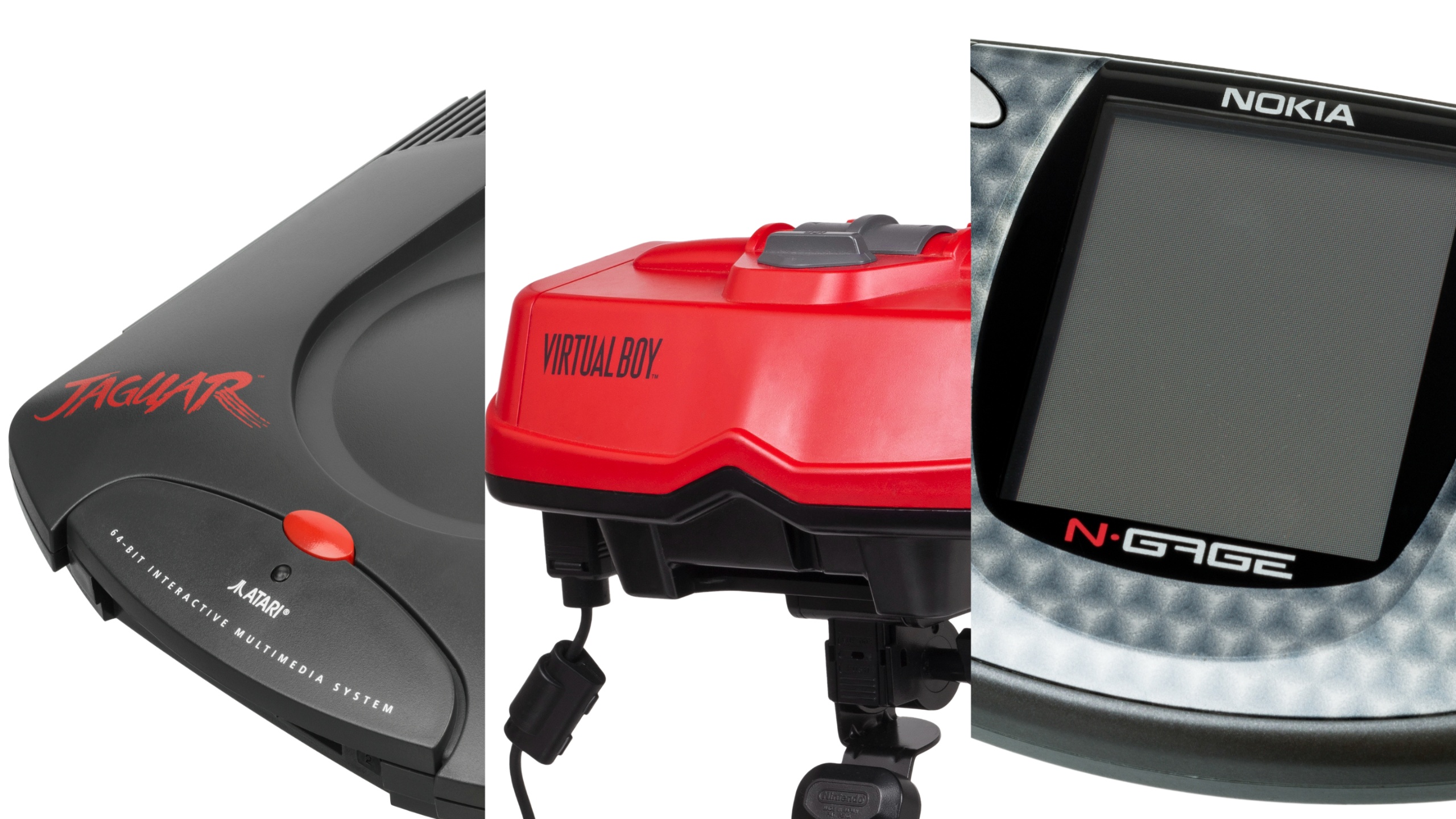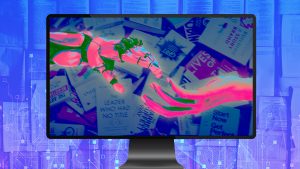
There are a lot of reasons why a video game console can fail. Bad marketing, outdated technology, excessive price, lack of third-party titles, the impact of solid competition, and so on. So many factors go into the existence of these devices and so much can go wrong. Even Nintendo has stumbled so hard that their faulty decisions occasionally leave radioactive footprints in video gaming history.
Not every console can be a major success story, but no console is truly without value. Well, maybe the Mattel HyperScan…but other than that! Every failed console has at least something worth checking out. Hell, the Sega Dreamcast had Marvel vs. Capcom 2 and SoulCalibur and it was still the death knell for Sega making hardware!
So here are some of the best games to come from game systems that fell flat.
Ms. Pac-Man for Atari 5200 (1983)
The Atari 5200 was a console that just wasn’t worth the jump forward. Yes, the graphics and capabilities were better than the Atari 2600, but restarting the library from scratch at a time when the longevity of your average title was still minuscule was a lot to ask. Especially when you throw that awful controller in there. If you’re going to look at any game as a highlight of the system, it’s best to go with Ms. Pac-Man.
Why? Well, part of it is the redemption factor. Pac-Man for the Atari 2600 was such a garbage fire of a port, and while Ms. Pac-Man for the same console was an improvement, it was still held back by its limitations. The 5200’s Ms. Pac-Man may not be arcade-perfect, but it’s such a leap from how undeveloped things looked on the previous console, that you can’t help but feel the impact of the newer hardware.
Flicky for SG-1000 (1985)
Sega’s first foray into consoles hit a wall, as the Famicom came out at the exact same time and had a lot more going for it. Yes, the SG-1000 was superior to what Atari was pushing at the time, but they fell short compared to Nintendo’s offerings. One of their better games was Flicky, an arcade port that is sort of…kind of the first release in the Sonic the Hedgehog expanded universe.
In it, you play as a bird trying to navigate looping stages and find smaller birds. Trailing them behind you, you then have to get them to the exit while evading or throwing random items at attacking cats who can kill you or at least disrupt your chain of follower birds. It’s outdone by the later Genesis port, but if you can stand Flicky’s graphical flickering, this is still a decent version of the arcade classic.
Chip’s Challenge for Atari Lynx (1989)
Chip’s Challenge was an Atari Lynx launch title, though it’s probably better remembered by anyone who had Windows in the early 90s. In this game, you play as Chip, a high school nerd who is obsessed with a brainy girl named Melinda. He chooses to prove his way into her genius club (and her heart) by surviving about 150 floors of puzzles and monsters, which are, apparently, owned and created by Melinda. Part of me wishes this lore got a movie adaptation, because I have so many questions.
Each floor throws more pitfalls and mechanics your way, getting increasingly difficult, but also addictive. It’s an incredibly long game, so unless you’re really dedicated to seeing Chip and Melinda go to e-prom, you’re fine just spending time with it until you grow bored or frustrated. Chip would get his resurgence in 2015 with the release of a sequel, followed by some rereleases of the original. There’s also the viral popularity of the Hot Chip Challenge, which probably doesn’t have anything to do with Chip’s Challenge, but you can’t prove that.
Tetris for Phillips CD-i (1992)
The CD-i is mainly remembered for having the worst versions of Mario and Zelda games in its library with most of its titles revolving around dull edutainment. At the very least, it does have its unique take on Tetris. At first glance, you might laugh, as much like previous entries on this list, it’s a title you can play on much better consoles. This may not be the best version of Tetris, but it’s such a distinctive experience that you have to give the CD-i its flowers just this once.
CD-i Tetris is a vibe. While the gameplay is the same, the actual Tetris part of it is only a fraction of the screen. The rest is dedicated to background visuals of nature, whether it’s a beautiful desert or an animated stream. More importantly, there’s Jim Andron’s breathtakingly chill vaporware soundtrack. Every track feels like the “Dire, Dire Docks” theme from Super Mario 64. This is the kind of game you would make Bruce Banner play to keep him from turning into the Hulk. Awesome use of what the CD-i was capable of.
Road Rash for 3DO (1994)
Where the 3DO Interactive Multiplayer really shined was in its superior ports. Their technology allowed for the closest things you could get to arcade or PC perfect, such as their versions of Samurai Shodown and Alone in the Dark. At the time, 3DO was the only console that could get you Super Street Fighter II Turbo, and it was slick outside of the need for a controller with more buttons. But since the beginning, the one game that truly had people’s attention was Road Rash.
Instead of being a solid port of an existing game, Road Rash was a gigantic upgrade to a series that never fully reached its potential on the Sega Genesis. The graphics, gameplay, style, and music all got a major shot in the arm. It even used the console’s ability to do FMV to its advantage while not being obnoxious about it. I mean, plenty of the game’s art direction was obnoxious, but in a good way. The Road Rash series didn’t last too long in the grand scheme of things, but its ride through the 3DO is considered to be the high point.
Alien vs. Predator for Atari Jaguar (1994)
Despite being the final chapter in Atari’s attempt to tackle the console market, the Jaguar did have some great titles in there. It’s widely agreed that the big trilogy of must-play games is Rayman, Tempest 2000, and Alien vs. Predator. Three very different games, but the latter is such a cool little piece of video game history that it gets the edge. Alien vs. Predator is a first-person shooter filled with a dread-fueled atmosphere and some great use of digitized graphics.
The big selling point of the game is that you can choose three different campaigns, based on playing as a Colonial Marine, a Predator, or a xenomorph. Each one comes with a different playstyle, set of strategies, and storyline. One of the neater touches is that the Predator can turn invisible to the Marines, but if he kills them in that form, he loses honor. There were talks of a console sequel, but the Jaguar was dying out before it had a chance to become something.
Virtua Fighter for Sega 32X (1995)
Sega’s second upgrade attachment to the Genesis was an utter disaster, and its existence was so brief that it only had a library of 40 games. The one thing it did excel at was arcade ports. There was some real gold there, especially when compared to what the Genesis itself was capable of. Games like Star Wars Arcade, Mortal Kombat II, NBA Jam: Tournament Edition, and Space Harrier kicked things up a notch. Still, it was Virtua Fighter that felt the most notable.
As the first polygon-based fighting game, Virtua Fighter was a revelation in the arcades. A port was released for the 32X that somehow acted true to the original, stretching the system to its absolute limits. It’s genuinely impressive, but it also shows why the 32X was doomed. Doing things better than 16-bit consoles was one thing, but the Saturn was already stepping over these feats. It grades extremely well, but it’s still on a curve.
Metal Slug for Neo Geo CD (1995)
The original Neo Geo console was a huge novelty in that you got to have arcade-perfect ports of SNK games at home…as long as you had plenty of money to spend because those cartridges cost hundreds of dollars each. In 1994, SNK released the Neo Geo CD, allowing for cheaper releases. A great idea, except the games came with increasingly dire load times. Earlier games were fine, but the later and heavier the title, the more you’d have to wait.
SNK released so many classic games on Neo Geo hardware and I would love to list all the dozens of fighting games that are worth playing, but the Neo Geo CD made playing through those a chore. This goes triple for King of Fighters games, as there would be lengthy load times between each round to switch out opponents. No, if you wanted a sweet spot for load times and quality, you had to try something like Metal Slug. The iconic run-and-gun had many sequels, but the original is the smoothest on this hardware and will annoy you the least. Even the sequel would pause to load before a boss fight.
Jack Bros. for Virtual Boy (1995)
You would think that Virtual Boy’s golden (er, ruby?) release would be a first-party title. Yes, Virtual Boy Wario Land and Teleroboxer were decent enough, but the game remembered for being a hidden gem was Jack Bros. by Atlus. The game stars Atlus mascot and Megami Tensei character Jack Frost, who has an hour to make it back to his home realm before midnight and has to fight through floors of monsters to survive. A spinoff of Megami Tensei where you fight through various floors of monsters…huh.
Anyway! You get to play between Jack Frost and his brothers Jack Lantern (who shoots projectiles slower, but stronger), and Jack Skelton (who has no projectiles, but does massive damage with his knife). The top-down action game has a cult following, with people wishing it wasn’t confined to a blinding console nobody owns on a cartridge nobody can afford. Give it a Switch remaster or something!
Super Marathon for Apple Bandai Pippin (1996)
There are plenty of reasons why this team-up between Apple and Bandai died such a horrible death, but the Pippin’s terrible library is near the top of that list. The Pippin was filled with educational garbage and the actual games were laughably bad. Power Rangers Zeo Versus the Machine Empire is a special kind of lousy, especially considering it was one of their marquee titles.
With such slim pickings on the grim Pippin, Super Marathon practically wins by default. It’s a package of Marathon and its first sequel, a pair of first-person shooters with a strong legacy due to laying down some major groundwork for the genre going forward. Seen as the Mac-friendly answer to Doom, the game was put together by Bungie, making it feel like a major early step towards Halo’s existence. Thankfully, the full trilogy of games is available for free, meaning you don’t have to invest in a Pippin. Unless you’re weird.
Tempest 3000 for Nuon (2000)
I mentioned Tempest 2000 as a beloved part of the Atari Jaguar’s library earlier, but I passed on it for the sake of discussing its lesser-known follow-up on a lesser-known console. The Nuon was a short-lived device that tried to make its name by enhancing DVD extras…which it does for only a couple throwaway titles from this era. The Nuon had no chance of survival, especially with how few games there were and how they weren’t compatible with every Nuon model.
The one reason anyone wants to own it isn’t the ability to truly experience Dr. Dolittle 2 in a way far beyond what regular DVD players are capable of. No, it’s because it is the only home to Tempest 3000. While the game has new mechanics compared to its prequel, what gives it that extra juice is its visual style. Tempest 2000 pops on its own, but Tempest 3000 feels like you’re at a rave and the drugs just kicked in. As much as the series’ fans would love to see it anywhere else, unfortunately programming it to the Nuon was such a specific task that trying to emulate it elsewhere isn’t seen as worth the trouble.
Tony Hawk’s Pro Skater for Nokia N-Gage (2003)
More than anything, the N-Gage was a badly designed piece of mobile hardware. There are so many issues with the way it was built and its layouts, but its problems really become apparent when you look at its ports. Games like Sonic N, Tomb Raider, and King of Fighters Extreme would be perfectly fine if not for the vertical screen mucking things up. It’s so hard to adjust to the view, making the whole experience so claustrophobic.
One port that thankfully works with the screen is Tony Hawk’s Pro Skater. That game’s focus on flashy, vertical jumps fit the device surprisingly well. This was a port that was allowed to really stand over what the Game Boy Color and Game Boy Advance were capable of. Not only did it look and play enough like the PlayStation game, but it even included assets from the sequel. Tony Hawk appeared on a lot of consoles, but if you wanted a high-quality take that you could play on the go, this was your Huckleberry.
Mario Kart 8 for Wii U (2014)
The Wii U might have been too busy to entice people to buy it in bulk, but much like the Virtual Boy, it can fall back on the fact that it’s still a Nintendo product. With that comes plenty of Nintendo first-party titles. Unfortunately, in this case, it’s a double-edged sword. That library is going to be the thing that works against the Wii U when it comes time for nostalgia. The Switch has been bowling a spare by just taking some of the better Wii U games, sprucing them up, and releasing them on a console the public actually wants to play.
Mario Kart 8 is an interesting case, as it’s the Wii U’s most successful title by far, as it should be. It’s freaking Mario Kart! The Switch version came out three years later and has become that console’s most successful title by far. In fact, comparing sales between the two, Mario Kart 8 Deluxe has sold 7 times as many copies as its Wii U counterpart. Yes, there are so many great games on the Wii U. There just aren’t many that are exclusive, making the system one giant shrug.
The post The Best Games For Failed Consoles appeared first on Den of Geek.






